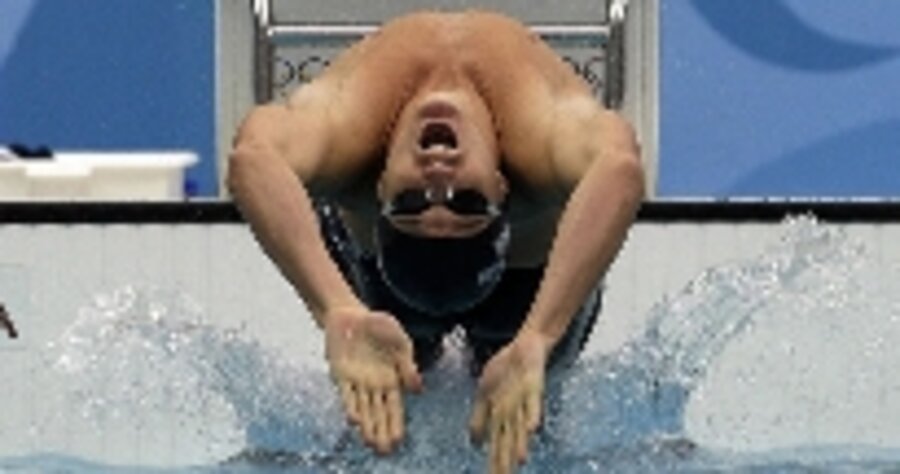Increased professionalism keeps swimmers in the pool
Loading...
| Beijing
Swimmer Aaron Peirsol now has a gold medal and a world record in Beijing to go along with his BMW and $439,000 home in Austin, Texas.
For a former Olympic swimmer like Glenn Mills, a member of the 1980 United States swimming team, Peirsol’s assets are almost beyond comprehension. “When we swam, it was questionable if we could even lifeguard, because that would be using our skill to make money,” he says. In the end, Mills says, he quit swimming because “you couldn’t earn any money in it."
Today, there is enough money for the top athletes to make the sport a comfortable career. In contrast to the days when swimmers could rarely continue beyond college, the three American gold medalists on Tuesday morning were all repeat Olympians well past their college days.
Both Peirsol, winner and world-record setter in the 100-meter backstroke, and Michael Phelps, winner and world-record setter in the 200-meter freestyle, are three-time Olympians. Women’s 100-meter backstroke winner, Natalie Coughlin, is in her second Summer Games. In all, six American swimmers are in at least their third Games.
“The whole dynamic has changed,” says John Lohn, a columnist for Swimming World magazine. And what has changed the most is sponsorship money.
Famously, Nike recently signed Cullen Jones, a swimmer who did not qualify for a single individual event in Beijing, to a $2 million endorsement deal. He is an exception, for as an elite African-American swimmer, he provides unique endorsement opportunities. But the offer hints at the sort of money now available as companies such as Speedo and Nike “realize this is good for advertising,” says David Wallechinsky, an Olympic historian.
The money is hardly spread evenly across the sport. “The drop-off is significant,” writes Gary Hall Jr., a three-time Olympian who missed making the current team, in an e-mail. “There are guys that are ranked top 10 in the world that are making $30,000 a year or less.”
But for top swimmers, like Peirsol, “money is not an issue,” says Mr. Lohn. A three-time gold medalist in Athens, Peirsol has endorsement deals with Nike, Toyota, and Bank of America, among others. For his part, if Phelps breaks the record of seven swimming gold medals won by Mark Spitz at the 1972 Olympics, he will receive a $1 million bonus from swimsuit manufacturer Speedo.
When Hall came to the sport in 1994, “there were maybe a half-dozen swimmers in the world that were making six-figure salaries from the sport of swimming,” he says. “Today, you have twice that many making seven figures.”
This change is in part due to the Phelps effect, with the record-breaking swimmer’s achievements raising the profile of the entire sport.
But the increased endorsements of swimmers began with Matt Biondi, who in 1990 challenged the swimming establishment and won. By holding a one-on-one, nationally televised, 50-meter freestyle match race with teammate Tom Jager – and keeping his share of the proceeds – he overturned the notion of amateurism. From that point, the code that kept 1980 Olympian Mills from becoming even a lifeguard was in decline. “After that the floodgates opened,” says Mills.
Phelps and the current generation of swimmers have been the beneficiaries of the increased professionalism of swimming. The US swimming team has also benefited, in many respects. As world swimming becomes more competitive, the US has been able to stay on top by keeping its best athletes in the pool for longer.
“Now, collegiate swimming is another step in the development of world-class swimmers,” says Bob Bowman, Phelps’s coach. “You’ll see [athletes] will get better performances at a more mature age, physiologically and psychologically.”
For the women, the ability to remain in the sport financially has allowed relatively older athletes to break stereotypes. “They’ve gotten rid of the stigma that once you hit 18 or 19 years, you can’t swim any faster,” says Lohn of Swimming World. Speaking of 40-something Dara Torres, he says: “Her stroke is as efficient as any in the sport.”
Three-time Olympian Hall has long been an outspoken advocate of a professional swimming circuit in the US. That remains a dream. But there are signs of progress. At the US Olympic Trials in Omaha, a temporary, three-meter-deep pool was constructed in a 12,000-seat basketball arena. Even in preliminary rounds, fans almost filled the upper deck.
It was an example, Hall says, of USA Swimming realizing at last how to promote the sport to a larger audience. “For the first time, swimming was presented as a ‘professional’ sport, in a proper venue and setting, with peanut and beer vendors, with the excitement and energy level that we experience in other professional sports on a regular basis,” he writes.
His one concern is that with more money now on offer, athletes may be tempted to cut corners. “This new problem of doping in sports could potentially make us yearn for the good old days when $1,200 a month was the plight of the swimmer and not the decision to have to take performance-enhancing drugs to compete with the world’s best,” adds Hall.
For the moment, however, most see the trend primarily as a positive. “You’re seeing a new breed of swimmers that you’ve never seen before,” says Brendan Hansen, a second-time Olympian who finished fourth in the men’s 100-meter breaststroke. “I honestly didn’t think I’d be swimming at 26 years old.”





